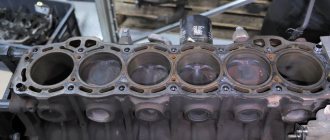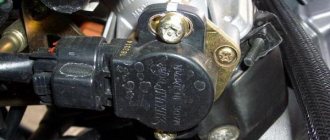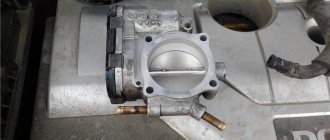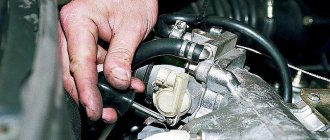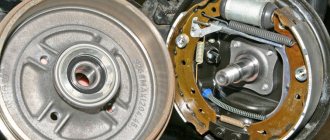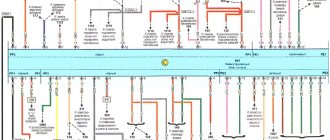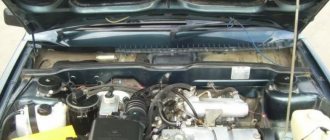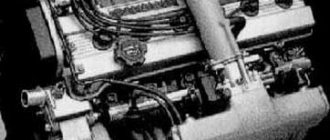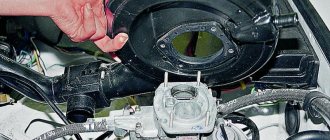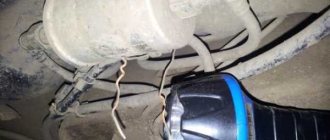Hi all. Today we’ll talk about the throttle assembly, how and for what reason oil gets there and how to fix it. You will learn why there is oil in the throttle valve and how to deal with it. The reason is quite common, so I think the article will be useful to many car enthusiasts.
Let's start with the fact that when the power unit is working properly, oil should not get into the throttle assembly, so if this happens, we can say with confidence that there is a malfunction that needs to be eliminated.
What does this mean? Oil in the throttle will quickly lead to the formation of a layer of dust, which will very soon turn into a thick, dense layer that interferes with the normal operation of the throttle assembly. The damper will begin to work incorrectly, not completely blocking the air supply, as a result, as a result, the engine speed will begin to fluctuate, and the operation will become unstable.
How does contamination of the throttle assembly manifest itself?
- Unstable engine speed.
- Poor engine starting.
- Short-term drops in speed.
- Poor pedal response.
Throttle position sensor
The car throttle position sensor itself is located in/on the throttle assembly and is popularly called the “right foot sensor”.
It measures the opening value of the throttle valve and transmits this data to the engine control unit.
This sensor is potentiometric type, i.e. works on the principle of a conventional variable resistor. We most often find variable resistors in volume controls of audio equipment and in many other parts of our everyday life.
There is an opinion that the throttle position sensor is almost the most important metering element in the engine control system and the load on the engine is calculated from its signal.
Let's be clear. This must be understood to correctly diagnose the car.
We have already mentioned in the article Lean mixture that an internal combustion engine runs on air with the addition of fuel vapor. We also realized that the main dosing factor is air flow!
Air flow is the main and starting factor for all subsequent actions taken by the ECU in the process of engine control.
From this we can correctly conclude that the throttle position sensor is not the main metering device.
You can turn it off and the car won’t be too upset about it, but will go on without any problems from point A to point B or C or D. In general, it will go where it needs to go.
The entire load on the engine will be based on data from the air flow measurement sensors.
And we control the mass of this very air by physically opening/closing the throttle valve.
Scanning and fault codes
In most cases, the electronic control unit will identify this as a malfunction of the throttle position sensor and report it by displaying the appropriate code. There are more than a dozen diagnostic codes (from P0120 to P0229) to indicate a malfunction of the throttle position sensor, so displaying any of them indicates a problem with the sensor.
Most scanners check the engine and throttle position in real time, that is, while the engine is running, but this is not very effective in diagnosing a malfunction of the throttle position sensor. The fact is that fluctuations in the electrical circuit of the sensor occur so quickly that the scanner is not able to display voltage changes. A scanner that reads every 0.1 seconds cannot detect voltage changes that occur every 0.09 seconds.
Throttle position (DZ position)
Despite all of the above, measuring the throttle position plays, although not the main, but very important role in the process of engine control. It helps you manage processes more accurately.
For example, an engine operating mode such as forced idling or cut-off mode (engine braking). The throttle position helps the ECU assess the situation and enable this mode.
Let's say the car speed is 55 km/h and the engine speed is 2600 rpm. We release the accelerator pedal, the throttle position becomes minimal, the ECU sees this and turns on the cut-off mode, turning off the fuel supply through the injectors. This allows you to use engine braking more effectively, increasing safety and extending the service life of the braking system, as well as saving fuel and significantly reducing the emission of harmful substances into our atmosphere.
But I’m lying if I don’t say that the ECU will already see that we have closed the damper due to a sharp drop in pressure in the intake manifold (with a DBP system) or a sharp decrease in the mass of air consumed (with a mass air flow sensor system). As we can see, in this case too, measuring the throttle position only helps to more accurately determine the cutoff or engine braking factor.
Throttle position at idle speed
What should be the readings of the DS position at idle speed?
This parameter is more relevant to ardent fanatics of cleaning the throttle valve every week, or even every other day.
There are two main ways to control idle speed using the IAC (idle speed controller). Just control the speed xx! And don’t maintain the speed xx! It is very important!
- Using the idle speed controller installed in the bypass channel
- Using an idle air control that directly controls the throttle valve
Both systems are found on different cars. Even the Chevrolet Lacetti uses a different way to adjust the idle speed. On 1.4L and 1.6L engines the second method is used, and on 1.8 engines the first method is used.
This parameter in diagnostics is called “IAC Steps” or “DZ Position Step”. We will look at this in more detail in one of the future articles, but now I will briefly explain what the fundamental difference between these two methods is. This is necessary to understand throttle position diagnostics.
As we already know, all processes in the engine begin with air supply. By supplying air, we can regulate engine speed in different modes. The same thing happens when adjusting the idle speed. By supplying a certain mass of air, we regulate the speed xx within the required limits.
Note! The idle speed regulator performs a rough adjustment of the idle speed (about +/- 50 rpm. After this, the idle speed is more precisely regulated by changing the speed limit. But this is the topic of another article and now it is not so important.
So, in the first case, the damper is completely closed, and the air required for idling is supplied bypassing the throttle valve through a special channel. This channel contains a special valve-regulator that regulates the mass of air passing through this channel.
And in the second case, the air supply is carried out through the throttle valve itself. The damper is opened/closed using an electric motor and the necessary air mass passes through it to allow the engine to idle.
That is, it is obvious that in the first case, when the engine is running in idle mode, the correct values of the DS position will be equal to zero! Since the air does not flow through the throttle valve, but through a special IAC channel.
And in the second case, when the engine is idling, the correct values of the DS position will be equal to several percent (degrees). The readings cannot be zero, because if the damper closes completely, then the engine will stall.
We already have our first conclusion. That's the essence of it.
To properly diagnose throttle position, the first step is to determine how the idle speed is adjusted on that particular vehicle. If according to the first method, then the position of the DS at idle should be equal to 0%! And if using the second method - then a few percent!
Note: There are exceptions in all areas of our lives. Here too. For example, although the Lacetti 1.8 LDA has a separate idle speed control, the throttle position at idle is 10-11%
In the first case, everything is simple and clear. If the values are different from zero, it means either the throttle valve cannot close tightly due to dirt or something else, or the throttle position sensor is not showing the truth, which means it is worn out and broken.
But in the second case, not everything is so simple.
There is an opinion that if the opening of the shutter is more than 5%, then mandatory cleaning of this very damper is necessary. This is true, but with many nuances.
And the most important of them are those that we have already talked about above:
- The idle speed regulator does not maintain idle speed, but regulates it
- The load on the engine is calculated by air flow (manifold pressure). The greater the mass of air consumed, the greater the load. Conversely, the greater the load on the engine, the more air it needs.
Throttle Body Cleaner
Just 15-20 years ago there were few compositions for cleaning throttle bodies in stores, and many car enthusiasts cleaned carburetors and injectors with various improvised means. Now there is no need for this - there is a wide range of auto chemicals on sale.
It’s not worth saving on a cleaner - you won’t be able to save a lot of money, and you may not achieve the desired result. Among the most well-known manufacturers of chemicals for throttle valves and carburetors are the following companies:
- Hi-Gear;
- Liqui Moly;
- 3ton;
- Yamalube;
- 3M;
- STEP UP;
- Abro.
Using cleaners, you can not only clean the throttle, but also the PCV ventilation valve (crankcase gases). Hi-Gear (“Synthetic Formula”) does not contain substances that destroy parts of the fuel system, so the product will not cause any harm. High Gear carburetor cleaner is available in cans with a capacity of 354 and 510 g; a large bottle is usually enough for two or three cleanings. The only serious drawback of Hi-Gear products is the rather high price.
STEP UP carburetor cleaner is cheaper, but in quality it is almost in no way inferior to High Gear. The cleaner comes with a regular and improved (synthetic) formula; the product has a very mild odor.
High throttle position
Very often you have to answer the same questions. The most important of them is this: “I cleaned the throttle valve, but its throttle position readings do not change and are 5-7%. Is the throttle assembly worn out?
Let me give you an example from life. The person was very puzzled by the inflated readings of the remote control position, which were about 7-9% at idle. Having read a lot of forums on the Internet and sites called “Pishulishbypisit”, I started ripping out the throttle assembly. I washed it - it didn't help. It means you didn't wash it well. I washed it again and very thoroughly. It didn't help again. What can I do? It’s already shiny, like something on a cat’s, but still according to the indications it’s dirty!
Then his puzzlement grew into a more drastic phase - probably the damper was jammed and not closing.
It’s good that at least I didn’t have time to disassemble the throttle assembly in search of a jam.
A timely, careful diagnosis revealed the cause of his sleepless nights.
The culprit turned out to be... the generator.
It only took one look at the accessory belt to know something was wrong.
It turned out that the generator rotor was spinning so hard that the engine did not have enough standard idle power to rotate it. And, naturally, the ECU opened the throttle valve slightly to allow more air to enter.
Low throttle position
Let's go back to cleaning the throttle body and set the record straight.
We often see this kind of rating of clean dampers.
People are really happy when, after cleaning (or not cleaning) the throttle valve, the readings of the throttle valve position are less than those of the loser who didn’t clean it well. He got 2.5%, but I got as much as 0.8%! Simply cool!
Should we be happy about such a low throttle position?
Again, not to be unfounded, let's conduct an experiment.
Let's take as a basis our well-known fact that for certain engine operating parameters a certain mass of air is required.
We connect the adapter for car diagnostics and start the engine at idle speed. We look at the parameter “DZ position”
The throttle position (opening) is 2.4%. The position of the idle air control (STEP) is 24
Disconnect any hose from the intake manifold. For example, a short hose from the crankcase ventilation system valve
This will ensure that excess air is sucked into the intake manifold.
Now let's look at the throttle position readings
The value of the remote sensing position became 0.8%! What a cool way to clean the throttle valve without even getting your hands dirty
And the position of the IAC became only 5 steps.
Is it clear what happened?
The mass of air entering through the disconnected hose is almost enough to keep the engine idling, so to prevent the speed from increasing above the required speed, the ECU closed the throttle valve.
Therefore, you should not rejoice at small throttle position values on cars with idle speed control using remote control!
There are two main reasons for low throttle position on Lacetti 1.4/1.6 and similar cars:
- Air leak into the intake manifold. This also reduces the idle speed control steps.
- The cable from the gas pedal to the throttle valve is not adjusted correctly. In this case, the idle speed control steps do not decrease, but remain normal.
I talk about this in more detail in the video at the end of this article. Be sure to watch it if your car has a low DS position.
The throttle valve will work more reliably with MODENGY coating
The throttle valve plays the role of a regulator of the supply of the fuel-air mixture to the internal combustion engine. The device, located between the air filter and the intake manifold, operates on the principle of an air valve. When the damper opens, the pressure in the system is compared with atmospheric pressure, and when closed, it decreases as much as possible - down to a vacuum.
Naturally, during operation the throttle valve becomes contaminated with fuel combustion products (Fig. 1). If the engine is equipped with an exhaust gas recirculation system, pollutants enter not only from the intake manifold, but also from the air duct.
Rice. 1. Throttle valve contaminated with fuel combustion products
Over time, due to the existing axial play, the valve rubs a groove up to 1 mm deep in the throttle body. The aluminum body of most dampers becomes worn out. As a result, the fuel mixture becomes leaner, idle speed becomes unstable and difficult to regulate. The smoothness of movement and acceleration dynamics of the car are disrupted.
You can minimize the risk of engine problems by treating the throttle valve with an anti-friction solid lubricant coating.
Coating allows you to:
- Smooth flap movement
- Increasing her sensitivity
- Preventing mechanism jamming
- Damper tightness
- Minimal wear of rubbing surfaces
Sometimes protective coatings are applied to the throttle body at the factory. In appearance, the treated surfaces resemble painted ones.
Rice. 2. Throttle body with and without coating
Over time, the protective coating on the damper can wear out or become damaged due to unqualified vehicle maintenance (it is mistaken for carbon deposits and attempts are made to remove it).
If the damaged coating is not restored, the smooth operation of the damper and its service life will be significantly reduced for the reasons discussed above.
MODENGY anti-friction solid lubricant coating is optimally suited for the valve and throttle body. For internal combustion engine parts. The material is applied to the surfaces after mechanical cleaning and treatment with a special MODENGY activator cleaner, which ensures maximum adhesion of the coating to the base.
MODENGY coating for internal combustion engine parts is available in convenient aerosol cans and cures at room temperature. This allows you to use it even in the absence of specialized equipment.
Thanks to molybdenum disulfide in the composition of MODENGY For internal combustion engine parts, it is resistant to aggressive environments (including fuels) and maintains its integrity throughout the entire service life of the damper. The coating protects the mechanism from corrosion and wear, prevents jamming, increases tightness and sensitivity.
For better efficiency, the material is applied in several layers, each of which is dried for 10 minutes. Recommended coating thickness is 20 ± 5 microns. Assembly of the unit is possible 12 hours after applying the last layer and keeping it at room temperature. Curing can be accelerated by heating the choke in an oven for 20 minutes at +170°C.
MODENGY coating for internal combustion engine parts is used to protect and improve the performance of not only the throttle valve, but also other engine components: piston skirts, valve rods, threaded and splined connections, crankshaft liners and camshafts.
For more detailed information and advice on solving specific problems, please contact.
Request information
← Back to articles
Correct throttle position
From all of the above, it is necessary to draw a general conclusion about the correct position of the throttle valve.
For vehicles with an idle speed control system using an IAC installed in a separate bypass channel, bypassing the throttle valve:
- The DS position value should usually be 0%. Increased values indicate an obstacle to closing the damper (dirt, jamming, damage, etc.) or a malfunction of the throttle position sensor itself or its wiring.
For vehicles with an idle air control system by acting on the throttle itself:
- The throttle position should usually be 2-4% on a fully warmed up and fully operational engine, including the serviceability of all its auxiliary units (generator, power steering pump) and consumers turned off (air conditioning, headlights, heated rear window, etc.)! An overestimated throttle position may be caused by increased, for some reason, load on the engine, contamination of the throttle sensor, or a malfunction of the throttle valve or its wiring. Low throttle position readings can be caused by excess air being sucked in bypassing the throttle valve (very common!) or by improper adjustment of the throttle valve drive.
We will not consider checking the throttle position sensor in this article, since I described this in detail in the article How to check the TPS
Controllability
The most worn and therefore most vulnerable part of the throttle position sensor is the thin section of the crescent-shaped resistive element, since it is in this part that the current collector is located most of the time, and this is where the greatest resistance to the passage of current occurs. Classic signs of a bad throttle position sensor include jerking during acceleration and floating idle speed.
Most often, sensor malfunction is manifested by an unstable electrical connection, and not directly by mechanical failure. The control unit recognizes an electrical connection failure as frequent opening and closing of the throttle valve, even if the driver does not touch the accelerator pedal. Oxygen sensors signal to the control unit that the air-fuel mixture ratio is incorrect, but the unit is not able to adjust the fuel supply quickly enough to ensure the correct mixture parameters. As a result, frequent and irregular fluctuations occur in idle mode, as well as random jerks during vehicle acceleration.
